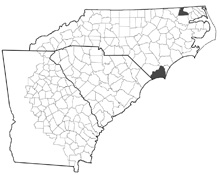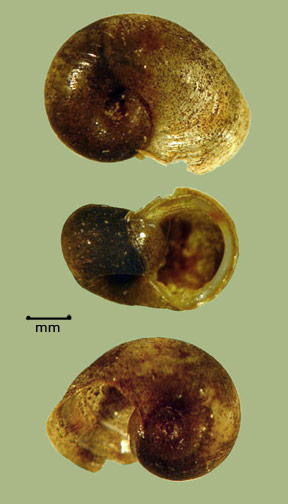> Habitat & Distribution
Helisoma
eucosmium has
previously been reported from but two sites, both in the Cape Fear
drainage of North Carolina: Greenfield Lake, in Wilmington (New Hanover
County), and Town Creek, a swampy stream in Brunswick County (Baker
1945, Burch 1989, Adams and Brady 1995). There is also a
dubious
record from Louisiana (Bartsch 1908). Our discovery of a
population in the Wiccacon River of NE North Carolina represents a
significant range extension. Helisoma eucosmium
is rare in our 17-state study area, FWGNA incidence rank I-1.
> Ecology & Life History
Very little is known about the biology of H. eucosmium. The species was feared extinct until the discovery of the Town Creek population in 1994 (SCFTM 1990, Adams and Brady 1995). All the individuals at that locality inhabited a densely vegetated area at a depth of less than 3m.
> Taxonomy & Systematics
Burch (1989, note 50) suggested that Helisoma eucosmium
might be a morphological variant of Helisoma anceps,
and neither he nor
Turgeon et al. (1998) included it in their systematic lists of the
North American freshwater gastropod fauna. Adams
&
Brady (1995) argued from their examination of fresh specimens that the
species is validly distinct. We tend to agree, noting that
in addition to its
diminutive size and peculiar coloration, the aperture of H. eucosmium is
distinctively oblique, as though the shell is carried more closely to
the body than typical for H.
anceps. But the discovery of a discreet, viable
population of H.
eucosimum would go a long way toward settling the matter.
The classification of the Planorbidae proposed by the tag team of Baker
(1945) and Hubendick (1955) remains, after 50 years, the basis for our
understanding of this large and diverse family of pulmonates
worldwide. See the essay of 11Apr08 available from the link
below
for more.
> Maps and Supplementary Resources
> Essays
- See my post to the FWGNA blog of 11Apr08 for a review of the Classification of the Planorbidae.
- Or view the (Hubendick 1955) classification of North American planorbids in a tabular format [here].
- See my post of 26Sept14 for good, comparative figures illustrating "The egg masses of freshwater pulmonate snails."
> References
Adams, W.F., and S.G. Brady. 1995.
Rediscovery of the aquatic gastropod Helisoma eucosmium (Bartsch,
1908), (Basommatophora: Planorbidae). Brimleyana
22:23-29.
Baker, F.C. 1945.
The Molluscan Family Planorbidae. The University of Illinois
Press. Urbana, Illinois.
Bartsch, P.
1908. Notes on the fresh-water mollusk (Planorbis magnificus)
and descriptions of two new forms of the same genus from the southern
states. Proc. US Nat. Mus. 33:
697-700.
Bogan, A. E., M. R. Raley
and J. F. Levine (2003) Final report on the
taxonomic status of the Greenfield ramshorn, Helisoma eucosmium
(Bartsch, 1908) and the magnificent ramshorn, Planorbella magnifica
(Pilsbry 1903) (Mollusca, Gastropoda, Planorbidae) from eastern North
Carolina. Unpublished report filed with the US Fish &
Wildlife Service, Asheville. 22 pp.
Burch, J.B. 1989.
North American Freshwater Snails. Malacological Publications, Hamburg,
Michigan.
Hubendick, B.
(1955)
Phylogeny in the Planorbidae. Trans. Zool. Soc. London 28:
453-542.
Scientific Council on
Freshwater and Terrestrial
Mollusks. 1990. (W. F. Adams,
Chair) A report on the
conservation status of North Carolina s freshwater and
terrestrial molluscan fauna.
Turgeon, D.D., et al.
1998.
Common and Scientific Names of Aquatic Invertebrates from the United
States and Canada: Mollusks. Amer Fish Soc Sp Pub 26, Bethesda,
Maryland.








